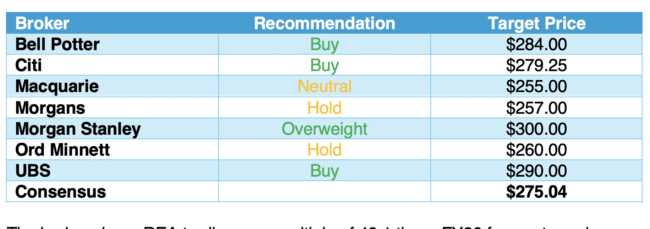Last week, property portal REA Group (REA) reported one of those sensational financial results: revenue up 15% to $1,673m, EBITDA up 18% to $969m, NPAT up 23% to $564m and a final dividend of $1.38, up 35%. Its operating margin in Australia increased by a staggering 4.7% from 59.9% to 64.6%. Not surprisingly, the shares soared, adding 5.5% over the week to close on Friday at $245.86.
Demonstrating its pricing power, the result came after a moderate uptick in new listings of 1%. REA continued to smash its nearest competitor, attracting a unique audience in April of 12.7m, 4x larger than Domain.
But platform businesses like REA could potentially be vulnerable to new disruptive business models driven by AI. They thrive because of the “network effect”, (that is, everyone has to use them), but their high margins make them ripe for others wanting to cherry pick. Does AI make this more likely? Let’s explore this thesis, plus insights from the brokers and the company’s outlook.
A strong year built on margin increases
Australian revenue for REA grew by 14% to $1,544m. Residential revenue (from residential property listings, rent listings and associated data products) grew by 16% to $1,156m due to a 10% average price increase, a better mix (vendors selecting premier listing categories) and a small increase in listings.
Revenue from commercial and developer listings grew by 10% to $218m, driven by a 12% price rise offset by a small decline in listings. Financial services revenue from REA owned mortgage brokers Mortgage Choice and Athena grew by 10% to $81m, while other revenue (from leads to real estate agents and display advertising) grew by 8% to $89m.
The other part of the REA piece is REA India, where revenue rose by 26% to $129m and the loss narrowed from $36m in FY24 to $28m in FY25.
Looking ahead, REA says that a further 7% average price increase in FY26 will support profit growth. It says that data and innovation is increasing customer value, and that penetration for Audience Maximiser (an additional product that uses social media to boost coverage) has doubled in the latest round of contracting. The financial services business has strong momentum, the developer market recovery is underway supported by demand, population growth and interest rate cuts, while REA India has been streamlined.
Management expects positive jaws (revenue increasing at faster rate than expenses, which means an increasing margin) into FY26 and FY27
The AI threat. Is it real?
To put the AI case, I went to the source – some AI programs. After “research” (extra and extended thinking by the AI program…this too some minutes), this is what Claude (from Anthropic) had to say: “REA Group is exceptionally vulnerable to AI disruption despite appearing dominant. Their $1.67 billion revenue relies on a vendor-paid model that has driven listing fees up 5,000% over 15 years to $5,000+ in Sydney. This creates massive margin for AI competitors to undercut while the ACCC is actively investigating their pricing practices for market power abuse.
The technical disruption path is proven globally. AI recommendation systems already achieve 90-98% accuracy in property matching, vastly outperforming REA’s passive “post-and-pray” model. Zillow demonstrates 98% valuation accuracy using neural networks, while Opendoor has processed thousands of direct transactions at 5% total costs versus traditional 6-7% plus listing fees. The technology exists and works.
Australian market conditions are ripe for disruption. Consumer and agent frustration is widespread – agents describe REA’s pricing as “extortionate” while consumers complain about poor search functionality and inaccurate data. REA has 2.6/5 stars on Trustpilot with reviews calling it a “price gouging monopoly.” This mirrors conditions before successful disruption in travel and retail.
Three viable AI business models could undercut REA:
- Direct AI matching platforms – eliminate expensive listings by proactively identifying qualified buyers, charging 1-2% transaction fees versus current $5,000+ listings
- Subscription-based agent tools – flat $200-500 monthly fees instead of percentage-based listing costs
- End-to-end AI transaction platforms – automate the entire buying/selling process with revenue from multiple touchpoints
The barriers are surmountable. PropHero already operates AI-powered property matching with $31 million valuation, while OpenAgent saves sellers thousands through 20-30% referral fees versus listing fees. Regulatory compliance is complex but achievable – existing players demonstrate viable pathways through licensed partnerships and technology service models.
Market timing favours disruption. CoStar’s $3 billion Domain acquisition brings serious competition with stated commitment to price competition. Over $3.2 billion in AI proptech investment in 2024 shows massive VC appetite, while the ACCC investigation creates regulatory tailwinds.
The opportunity is enormous. REA’s 57% EBITDA margins on a $996 million residential listings market provide exceptional room for competitors to offer better value. Well-funded international players or Australian consortiums could realistically achieve meaningful market share within 3-5 years by focusing initially on AI tools for agents, then scaling to direct buyer-seller platforms.
The convergence of proven AI technology, regulatory pressure, consumer dissatisfaction, and new competitive threats creates the most significant disruption opportunity in Australian digital marketplaces since the internet’s early days.”
I don’t agree with all Claude’s arguments, particularly around the “enormous opportunity” or “market timing” assertions. Just because something is attractive doesn’t mean it will be disrupted. But I think there could be a proposition around a direct AI matching platform, which might take the form of algorithmic buyer identification eliminating the need for premium listings or AI recommendation engines proactively matching properties to qualified buyers. The positions taken by the large real estate agent chains will be interesting to watch.
What do the brokers say?
With the possible exception of Macquarie, the brokers don’t seem too concerned about business model disruption. They are more worried about CoStar (which has purchased Domain) and whether actions it takes to boost Domain’s share may require REA to spend more on marketing and put downward pressure on the margin.
Overall, they are pretty positive on REA with most forecasting “double digit” earnings growth across FY26 and FY27. On valuation, they see upside with the consensus target price of $275.04, approx. 11.9% higher than Friday’s close of $245.86. The table below shows individual target prices and recommendations.

The brokers have REA trading on a multiple of 48.1 times FY26 forecast earnings and 40.6x FY27 forecast earnings.
Maybe my concerns about AI disrupting REA are misplaced because its network position is so strong. Time will tell. More immediately, however, it faces the threat of a cashed up CoStar spending millions on marketing, product innovation and crunching prices to win share. There is also an ACCC investigation to contend with. While there is no doubt that REA is a fabulous business, with the risks outlined above plus the fact that REA is trading on a “jaw dropping” multiple of 40.6 times FY27 earnings, it is really hard to make the case to invest in.
Pass.

